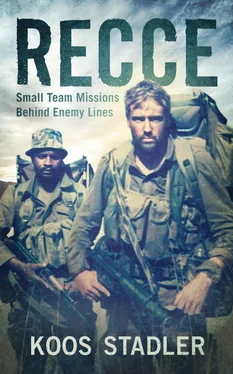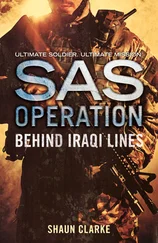By midnight, having covered only two kilometres, we were already bone tired and decided to move into a hide and rest. At first light I went up the mountainside and kept a lookout for the day while Vic stayed with the kit. From my vantage point I could see our route stretching north through the barren countryside. It was very uneven terrain, and I realised that we needed to pick up the pace and at the same time preserve our precious water.
We moved out by late afternoon, utilising the last light of the day to make up for lost time. We had agreed to cover ten kilometres that night, although I knew it was a tall order. But in the valleys among the mountain ridges the going was comparatively easier and we finally settled into a steady pace.
But I was not destined to see my first operation through. In the early hours of the morning, having covered most of our intended stretch for that night, I stepped on a loose rock and badly sprained my ankle – the same one I had injured in the night contact with 53 Commando at Nkongo the year before. I tumbled down the slope with my kit. The moment I managed to disengage myself from the heavy backpack, I realised I was out of the game. Within minutes my ankle was swollen, and no matter how we strapped it up, it wouldn’t fit into my boot. There was no way it would sustain the weight of the kit.
My predicament left us with few options. A helicopter evacuation so close to Caraculo would mean certain compromise, but Vic could not carry all the equipment and finish the job alone. The only solution was for Vic to join the other team while I waited in the area. So it was decided that the other team would move in to our position. We would then rearrange the equipment so that the newly formed three-man team – Neves, Da Costa and Vic – could carry five charges. I would remain in the area until their return.
Fortunately Neves and Da Costa, having made about the same progress as we had, were no further than four kilometres to our east. Through the Tac HQ we arranged for an RV at a prominent feature close to us, and late that afternoon Vic went to meet them and led them to our hide.
I kept enough food and water to last me another seven days and gave the rest to Vic, while I took the HF radio. The team also took one Pick and enough Slurry for one charge from me. Between the three of them they would still be able to place five charges.
At last light they disappeared into the night. After the noise and movement of the repacking, I decided to move out and find a new hide where I would feel more secure. I cut my boot open and forced my strapped foot inside, then wrapped it all up again with dems tape (an exceptionally strong adhesive tape used in the preparation of demolitions). Moving around was slow and painful, but I managed to cover about a kilometre and settled in a good hide halfway up the slope of a mountain.
What followed was an extraordinary experience, even though I was no longer taking part in my own carefully planned operation. I was used to being alone and doing my own thing; in fact, I took pride in being able to live with my own good company for long periods. In the past I had often gone on solo hiking and camping trips, which I enjoyed immensely and always used as opportunities to cleanse body and soul. But this was a new experience, as I now had to deal not only with the loneliness but also with the threat of discovery by the local population or FAPLA. Although the rugged mountainous terrain offered good cover and excellent escape routes, there was almost no vegetation, and I had to take great care not to expose myself during daytime. As I knew that I would be hampered by my injured ankle if located by the enemy, I carefully applied proper tactics. By that time anti-tracking formed part of my everyday routine, but I still made sure I left no sign of my presence.
We had agreed to stick to the same radio scheds so I could receive the team’s messages and monitor their progress. Dave Scales was as prompt and efficient as ever. He got both teams in the hopping mode [14] The Syncal 30 HF radio, as well as the base station radios, were equipped with “hopping mode”, a function whereby the two (or more) radios would use the same code to synchronise and then run (“hop”) through different frequencies while communicating. This was applied as an electronic counter-countermeasure (ECCM) to disrupt enemy listening-in or direction-finding devices.
simultaneously and let Da Costa transmit the team’s message first. Then he closed them down and had me transmit my message. I was surprised to learn how much distance the team had covered. Two more nights and they would be at the target.
Over the next seven days Dave Scales became my closest companion. We had two scheds a day, but the afternoon call was aimed mainly at boosting morale and guiding me through the long hours of hiding. Dave would check if I was on the air and then start an extensive broadcasting regime. He shared snippets of news from home, read newspaper cuttings he thought I might find interesting, and told jokes. This was essentially a one-sided conversation, as I could not afford to transmit, both to save battery power and to avoid detection by enemy electronic measures. However, Dave, who broadcasted from the base station at Ondangwa, could chat away – an opportunity he wouldn’t have passed up.
Every day Billy Joel’s “Piano Man” would be carried to me on the airwaves, since the song is all about loneliness. To this day, whenever I meet up with Dave or call him on the phone, our opening line is always “And he’s talkin’ to Davy, who’s still in the Navy/And probably will be for life”, from that touching song.
The team made good progress, and, two nights later, after observing the railway line for a full day, they started placing their charges. They planted the first one west of Caraculo, and then started working east towards the Serra de Leba mountains. By the time the second mine had been planted, they were fifteen kilometres east of the position of the first charge, the area where Vic and I would have operated. Since they were still heading east, it wouldn’t make sense for them to return to my position once the job was done. They were running low on water and had a long distance to reach the RV. I therefore decided to start moving back towards the LZ area so the team could head straight there.
I moved only at night and took exceptional care with my injured foot. Before first light I would find a hide as high up the mountainside as possible and spend the day observing the trail I had covered during the night. By this time I was also low on water, but kept a strict routine and refrained from drinking during the day.
I reached the cache area on the seventh night after splitting from the team, a few days before they would arrive. I was now out of water, but forced myself to observe the area for another day before moving in. Just before last light I approached the cache, having left my kit in a hide up the mountain. The area was undisturbed and all the caches untouched. Very relieved, I removed a water bag and took it back to my hide, from where I kept a lookout while I waited for the team.
When they arrived a few nights later, I had already taken some stock from the cache, as they were completely out of water and running low on food. They reported that they had used all the Slurry to beef up three charges planted over a distance of 20 km.
We were picked up by the two Pumas late the following afternoon. After refuelling at Opuwa, we headed straight back to Fort Rev, where oom Boet Swart and Dave Scales had prepared a five-course meal as a welcoming feast for us.
Over the next few months we received three reports from Intelligence at Special Forces HQ of diesel-electric units that had detonated charges on the line between Namibe and Lubango. Rail traffic came to a halt as the train drivers started to refuse to travel on that stretch. In spite of FAPLA’s efforts to locate and destroy the mines, the charges kept exploding one after the other, always targeting the diesel-electric unit itself.
Читать дальше












